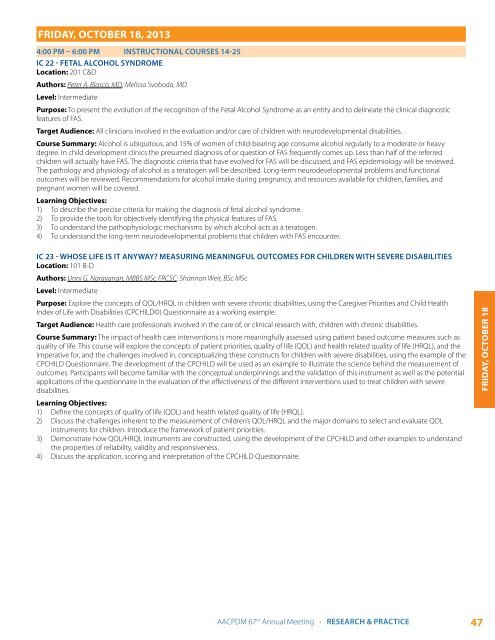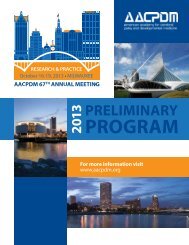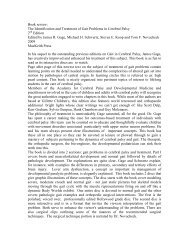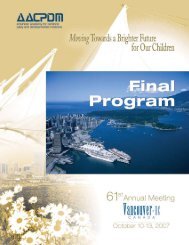Friday, October 18, 20134:00 pm – 6:00 pm Instructional Courses 14-25IC 20 - ORTHOPAEDIC TREATMENT OF PATIENTS WITH MYELOMENINGOCELE AND THE ROLE OF EARLY ADAPTIVEMOBILITYLocation: 203 CAuthors: Vineeta T. Swaroop, MD; Lauren Rosen, PT MPT MSMS, ATP/SMS; Luciano Dias, MD; Lauro Machado Neto, MDLevel: IntermediatePurpose: To review the overall orthopaedic care of patients with myelomeningocele including pathology of the hip, knee, ankle/foot, <strong>and</strong>rotational de<strong>for</strong>mities. Course will center around new advances in treatment <strong>and</strong> current evidence-based treatment recommendations, witha focus on the importance of early adaptive mobility.Target Audience: This course is relevant to all clinicians caring <strong>for</strong> patients with myelomeningocele including orthopaedic surgeons,physiatrists, physical <strong>and</strong> occupational therapists, orthotists, <strong>and</strong> pediatricians.Course Summary: The orthopaedic treatment of patients with myelomeningocele will be covered, focusing specifically on recent advancesin treatment <strong>and</strong> evidence-based care. Whenever possible, case-based discussion will be utilized. Topics addressed will include use of theFunctional Mobility Scale <strong>for</strong> classification; the role of motion analysis in treatment; the case <strong>for</strong> early adaptive mobility; relationship betweencrutch- walking, trunk movement, <strong>and</strong> valgus stress at the knee joint; current treatment recommendations <strong>for</strong> hip dislocation; update on thetreatment of clubfoot <strong>and</strong> vertical talus; use of a custom-molded total body splint as an alternative to spica casting.Learning Objectives:1) To underst<strong>and</strong> the importance of early adaptive mobility <strong>and</strong> review the supporting research.2) To gain knowledge of how to utilize the Functional Mobility Scale to classify patients <strong>for</strong> clinical, research, <strong>and</strong> outcomes uses.3) To underst<strong>and</strong> the role computerized gait analysis plays in the assessment <strong>and</strong> treatment of patients with myelomeningocele.4) To underst<strong>and</strong> the current treatment recommendations <strong>for</strong> hip dislocation/ subluxation, valgus stress at the knee joint, clubfoot/verticaltalus <strong>and</strong> other orthopaedic problems.FRIday, October 18IC 21 - DOES TRACHEOSTOMY IMPROVE QUALITY OF LIFE FOR CHILDREN WITH UPPER MOTOR NEURON DISEASE ANDFOR THEIR FAMILIES? A DEBATELocation: 202 BAuthors: Alex<strong>and</strong>er L. Okun, MD; Garey Noritz, MD; Janine Winters, MDLevel: AdvancedPurpose: 1.To examine whether the benefits of tracheostomy outweigh the risks <strong>and</strong> burdens <strong>for</strong> individuals with compromised upper <strong>and</strong>lower airway function due to severe cerebral palsy or other childhood onset central nervous system disabilities 2. To explore the experienceof families <strong>and</strong> loved ones involved in their care.Target Audience: Physicians, nurses, occupational, physical, respiratory <strong>and</strong> speech <strong>and</strong> language therapists, home care professionals,mental health professionals, family caregiversCourse Summary: An in-depth, critical review of medical <strong>and</strong> psychosocial factors pertinent to collaborative decision-making abouttracheostomy in this group.Learning Objectives:1) Underst<strong>and</strong> the association of upper motor neuron dysfunction with the risk of significant upper <strong>and</strong> lower airways compromise due todisturbances of pharyngeal tone, swallowing, h<strong>and</strong>ling of secretions <strong>and</strong> airway protective reflexes.2) Review current, evidence based, practical <strong>and</strong> balanced recommendations regarding medical <strong>and</strong> surgical treatments, includingtracheostomy, <strong>for</strong> individuals in this group.3) Integrate research findings on health status, hospitalizations, survival <strong>and</strong> quality of life <strong>for</strong> individuals in this group, <strong>and</strong> the experiencesof family caregivers, into ethically sound decision-making practices to improve their well being.4) Foster interdisciplinary communication <strong>and</strong> interchange among all allied health care professionals around this topic, anticipating adiversity of views <strong>and</strong> in<strong>for</strong>ming experiences.46<strong>American</strong> <strong>Academy</strong> <strong>for</strong> <strong>Cerebral</strong> <strong>Palsy</strong> <strong>and</strong> Developmental Medicine • FINAL PROGRAM
Friday, October 18, 20134:00 pm – 6:00 pm Instructional Courses 14-25IC 22 - FETAL ALCOHOL SYNDROMELocation: 201 C&DAuthors: Peter A. Blasco, MD; Melissa Svoboda, MDLevel: IntermediatePurpose: To present the evolution of the recognition of the Fetal Alcohol Syndrome as an entity <strong>and</strong> to delineate the clinical diagnosticfeatures of FAS.Target Audience: All clinicians involved in the evaluation <strong>and</strong>/or care of children with neurodevelopmental disabilities.Course Summary: Alcohol is ubiquitous, <strong>and</strong> 15% of women of child-bearing age consume alcohol regularly to a moderate or heavydegree. In child development clinics the presumed diagnosis of or question of FAS frequently comes up. Less than half of the referredchildren will actually have FAS. The diagnostic criteria that have evolved <strong>for</strong> FAS will be discussed, <strong>and</strong> FAS epidemiology will be reviewed.The pathology <strong>and</strong> physiology of alcohol as a teratogen will be described. Long-term neurodevelopmental problems <strong>and</strong> functionaloutcomes will be reviewed. Recommendations <strong>for</strong> alcohol intake during pregnancy, <strong>and</strong> resources available <strong>for</strong> children, families, <strong>and</strong>pregnant women will be covered.Learning Objectives:1) To describe the precise criteria <strong>for</strong> making the diagnosis of fetal alcohol syndrome.2) To provide the tools <strong>for</strong> objectively identifying the physical features of FAS.3) To underst<strong>and</strong> the pathophysiologic mechanisms by which alcohol acts as a teratogen.4) To underst<strong>and</strong> the long-term neurodevelopmental problems that children with FAS encounter.IC 23 - WHOSE LIFE IS IT ANYWAY? MEASURING MEANINGFUL OUTCOMES FOR CHILDREN WITH SEVERE DISABILITIESLocation: 101 B-DAuthors: Unni G. Narayanan, MBBS MSc FRCSC; Shannon Weir, BSc MScLevel: IntermediatePurpose: Explore the concepts of QOL/HRQL in children with severe chronic disabilities, using the Caregiver Priorities <strong>and</strong> Child HealthIndex of Life with Disabilities (CPCHILD©) Questionnaire as a working example.Target Audience: Health care professionals involved in the care of, or clinical research with, children with chronic disabilities.Course Summary: The impact of health care interventions is more meaningfully assessed using patient based outcome measures such asquality of life. This course will explore the concepts of patient priorities, quality of life (QOL) <strong>and</strong> health related quality of life (HRQL), <strong>and</strong> theimperative <strong>for</strong>, <strong>and</strong> the challenges involved in, conceptualizing these constructs <strong>for</strong> children with severe disabilities, using the example of theCPCHILD Questionnaire. The development of the CPCHILD will be used as an example to illustrate the science behind the measurement ofoutcomes. Participants will become familiar with the conceptual underpinnings <strong>and</strong> the validation of this instrument as well as the potentialapplications of the questionnaire in the evaluation of the effectiveness of the different interventions used to treat children with severedisabilities.Learning Objectives:1) Define the concepts of quality of life (QOL) <strong>and</strong> health related quality of life (HRQL).2) Discuss the challenges inherent to the measurement of children’s QOL/HRQL <strong>and</strong> the major domains to select <strong>and</strong> evaluate QOLinstruments <strong>for</strong> children. Introduce the framework of patient priorities.3) Demonstrate how QOL/HRQL instruments are constructed, using the development of the CPCHILD <strong>and</strong> other examples to underst<strong>and</strong>the properties of reliability, validity <strong>and</strong> responsiveness.4) Discuss the application, scoring <strong>and</strong> interpretation of the CPCHILD Questionnaire.FRIday, October 18AACPDM 67 th Annual Meeting • Research & Practice 47
- Page 1 and 2: 2013 FINALProgramFor more informati
- Page 3 and 4: 2012-2013 BOARD OF DIRECTORSPreside
- Page 5 and 6: Meeting at a GlanceFRIDAY, OCTOBER
- Page 7 and 8: 67th Annual MeetingOctober 16-19, 2
- Page 9 and 10: AACPDM 67 th Annual Meeting2013 Mob
- Page 11 and 12: General Meeting InformationTicketed
- Page 13 and 14: Membership BenefitsHow can you bene
- Page 15 and 16: Invited LecturersStrategic Research
- Page 17 and 18: Grants and ScholarshipsAACPDM Resea
- Page 19 and 20: Wednesday, October 16: Pre-Conferen
- Page 21 and 22: Wednesday, October 16: Pre-Conferen
- Page 23 and 24: Thursday, October 17, 20137:00 am-7
- Page 25 and 26: Thursday, October 17, 20138:00 am-1
- Page 27 and 28: Thursday, October 17, 201310:45am -
- Page 29: Thursday, October 17, 20132:00 pm -
- Page 32 and 33: Thursday, October 17, 2013THURsday,
- Page 34 and 35: Thursday, October 17, 2013THURsday,
- Page 36 and 37: Friday, October 18, 20136:00 am-6:4
- Page 38 and 39: Friday, October 18, 20137:00 am-7:5
- Page 40 and 41: Friday, October 18, 201310:30 am-12
- Page 42 and 43: Friday, October 18, 201312:30 pm -
- Page 44 and 45: Friday, October 18, 20134:00 pm - 6
- Page 48 and 49: Friday, October 18, 20134:00 pm - 6
- Page 50 and 51: Saturday, October 19, 20137:00 am-7
- Page 52 and 53: Saturday, October 19, 20138:00 am-1
- Page 54 and 55: Saturday, October 19, 201310:15 am-
- Page 56 and 57: Saturday, October 19, 20131:30 pm-3
- Page 58 and 59: Saturday, October 19, 20131:30 pm-3
- Page 60: Saturday, October 19, 20131:30 pm-3
- Page 63 and 64: Scientific PostersSP1 - REDUCTION I
- Page 65 and 66: Scientific PostersSP38 - IMPACT OF
- Page 67 and 68: Demonstration PostersDP1 - TRACKING
- Page 69 and 70: AACPDM Past and Future Presidents19
- Page 71 and 72: Exhibiting and Sponsoring Organizia
- Page 73 and 74: Exhibiting and Sponsoring Organizia
- Page 75 and 76: Disclosure IndexA=Research and inst
- Page 77 and 78: Disclosure IndexG9 Park, M (F) Chun
- Page 79 and 80: Disclosure IndexInvited SpeakersBac
- Page 81 and 82: Author IndexChan, Jeremy ..........
- Page 83 and 84: Author IndexGutman, Karli .........
- Page 85 and 86: Author IndexMatsumoto, Hiroko. ....
- Page 87 and 88: Author IndexSSaavedra, Sandra .....
- Page 89: Author IndexWingate, Martha .......







